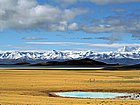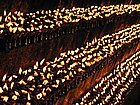西藏手册(83):拉萨(4)-大昭寺之三
西藏手册(83):拉萨(4)-大昭寺之三
======= Second Floor (access from S-E corner) =========
Zhalre Lhakhang
The chapel immediately above the Jowo Rinpoche Lhakhang was
remodelled by Zangkar Lotsawa when the lower chamber was enlarged.
Only the westernmost part of the original chamber remains, offering a
view of the chapel below, and this is approached by a recently
constructed catwalk - the origianl approach being walled-off to
prevent pilgrims walking above the Jowo Lhakhang. The remaining E
inner wall contains origianl frescoes. Unforunately, the 7th century
frescoes of the N wall were removed in the 1980s. The southern
frescoes and the well-preserved three-panelled mural of the E wall
suggest a synthesis of Tibetan and Pala styles, predating the
integrated Tibeto-Newar style of the 15th century.
Guru Lhakhang (Barkhang Lopon)
A 7th century tapering door-frame with metal lattices leads into this
chapel, where the central image depicts Padmasambhava in the awesome
form known as Nangsi Zilnon, flanked by his two foreign consorts and
eight manifestations. The original Pala-style paintings of the
outside walls (probably by Zangkar Lotsawa) were restored in 1991.
Demchok Lhakhang
Here the principal image depicts the mediational deity Cakrasamvara
in union with the female consort Vajravarahi.
Thuwang Tsokhor
Bypassing three empty chapels, the pilgrim arrives at this shrine,
which has images of Shakyamuni surrounded by the Eight Bodhisattvas;
and also Jowo Shakyamuni, flanked by Shariputra and Maudgalyayana.
Ku-nga Gonkhang (Gonkhangphuk)
This chapel contains nine 1.5m images of the protector deities,
including the five forms of Pehar known as Gyelpo Ku-nga, as well as
Hayagriva, Shridevi, and Nechung, and the gatekeepers Du-tsen and
Lu-tsen.
Chogyel Songtsen Lhakhang
The main shrine of the W wing, surmounted by a gilded roof, is
dedicated to King Songtsen Gampo. Note the 7th century door-frames.
The king's ale pot, known as Chogyel Trungben, or Chang-no Tamgochen,
which may perhaps be of Scythian or Kushan origin, is kept in a
cabinet on a wooden stand between the two gates. The central image of
the king, flanked by his two foreign wives, is said to have been
originall commissioned by Bhrikuti (the middle finger of the main
image is said to be that of Songtsen himself and the image an exact
likeness). Behind are images of the Seven Generations of Past Buddhas
and wall-painted mandalas. The S wall has further images of Songtsen
Gampo with Wengcheng and his Tibetan consort.
Thupa Rigdruk Lhakhang
The chapel of the NW corner is dedicated to Four-armed
Avalokiteshvara, flanked by the Six Sages of the Six Realms. Note the
multiplicity of murals depicting Amitayus in red on a cream
background.
The chapels of the N wing and those beyond the Zhalre Lhakhang on the
E-wing have been destroyed and are presently unrestored.
========= Third Floor (access from the SE and NW corners) =========
The frescoes of the third floor depict the protectors, especially
Shridevi. Many murals however have four or five layers of paint, of
which the lower layers have yet to be inspected. Only three chapels
are open.
Pelhachok dukhang (Meru Tshokhang)
This chapel is dedicated to the protectress Shridevi, and it is
cared for by the monks of Meru Sarpa Tratsang. There are new murals
in white, red and gold on black background, which depict Shridevi,
Mahakala, and Bhairava. The murals outside this chapel depict
Six-armed Mahakala, Dalai Lama V, the regent Desi Sangye Gayatso,
and Gushri Qan, with Magzorma, Shridevi, and the Twelve Tenma.
Palden Lhamo Lhakhang
This chapel contains a peaceful image of Shridevi.
Pelha Bedongma Lhakhang
Here, the wrathful image of frog-faced Shridevi is separeated from
the previous chapel by a partition wall. On the 13th day of the 10th
lunar month, this image would be displayed for 3 days, and on the
full-moon day it would be carried around the Barkhor during the
festival known as Pelhe Rida.
Closed chapels on this floor include: (W) Lama Lhakhang,
Tsephak Lhakhang, Sangdejiksum Lhakhang, Neten Chudruk Lhakhang;
(N) Menlha Deshegye Lhakhang, Menlha Tsokhor Lhakhang,
Tonpa Toskhor Lhakhang, Drelzam, Deshegye Lhakhang, Thuwang Tsokhor;
and (E) Jowo Utho Lhakhang.
======== The Roof ============
There are four gilded roofs (gyaphib) and four corner chapels on the
roof of the Jokhang. The former comprise: the Jowo Gyaphib in the
Centre-East, the largest gilded roof, which was donated by Tew Mul,
the ruler of Yartse Kingdom of W Tibet in the 14th century; the
Jampa Gyaphib in the Centre-South; the Chogyel Gyaphib in the
Centre-West, which was commissioned by Dalai Lama V; and the
Tuje Gyaphib in the Centre-North, which was donated by the kings
Punimul and Pratimul of Yartse in the late 14th century.
As to the four corner chapels: the Pelhayum Drakmo Lhakhang in the
SE (now closed) is dedicated to Magzorma, the Tsering Chenga Lhakhang
in the SW (now closed) is cared for by the monks of Tsurphu; the
Neten Chudruk Lhakhang in the NE (now closed) was formerly utitlized
by the Tibetan Government during the Great Prayer Festival; and the
Lhachak Shokhang in the NW (now closed) once functioned as a
government stationery supplier. Also on the Jokhang roof are the
Lhabum Lubum charm vases; and the Tamnyen Darchen flag, which was
erected by Desi Sonam Chopel following the defeat of Beri Kingdom
during the 17th century. The bright sunlit roofs present a great
contrast to the dark smoke-filled chapels of the Jokhang's interior.
TIBET HANDBOOK
Gyurme Dorje
Trade & Travel Publications Ltd. January 1996
ISBN 0 900571 69 X
======= Second Floor (access from S-E corner) =========
Zhalre Lhakhang
The chapel immediately above the Jowo Rinpoche Lhakhang was
remodelled by Zangkar Lotsawa when the lower chamber was enlarged.
Only the westernmost part of the original chamber remains, offering a
view of the chapel below, and this is approached by a recently
constructed catwalk - the origianl approach being walled-off to
prevent pilgrims walking above the Jowo Lhakhang. The remaining E
inner wall contains origianl frescoes. Unforunately, the 7th century
frescoes of the N wall were removed in the 1980s. The southern
frescoes and the well-preserved three-panelled mural of the E wall
suggest a synthesis of Tibetan and Pala styles, predating the
integrated Tibeto-Newar style of the 15th century.
Guru Lhakhang (Barkhang Lopon)
A 7th century tapering door-frame with metal lattices leads into this
chapel, where the central image depicts Padmasambhava in the awesome
form known as Nangsi Zilnon, flanked by his two foreign consorts and
eight manifestations. The original Pala-style paintings of the
outside walls (probably by Zangkar Lotsawa) were restored in 1991.
Demchok Lhakhang
Here the principal image depicts the mediational deity Cakrasamvara
in union with the female consort Vajravarahi.
Thuwang Tsokhor
Bypassing three empty chapels, the pilgrim arrives at this shrine,
which has images of Shakyamuni surrounded by the Eight Bodhisattvas;
and also Jowo Shakyamuni, flanked by Shariputra and Maudgalyayana.
Ku-nga Gonkhang (Gonkhangphuk)
This chapel contains nine 1.5m images of the protector deities,
including the five forms of Pehar known as Gyelpo Ku-nga, as well as
Hayagriva, Shridevi, and Nechung, and the gatekeepers Du-tsen and
Lu-tsen.
Chogyel Songtsen Lhakhang
The main shrine of the W wing, surmounted by a gilded roof, is
dedicated to King Songtsen Gampo. Note the 7th century door-frames.
The king's ale pot, known as Chogyel Trungben, or Chang-no Tamgochen,
which may perhaps be of Scythian or Kushan origin, is kept in a
cabinet on a wooden stand between the two gates. The central image of
the king, flanked by his two foreign wives, is said to have been
originall commissioned by Bhrikuti (the middle finger of the main
image is said to be that of Songtsen himself and the image an exact
likeness). Behind are images of the Seven Generations of Past Buddhas
and wall-painted mandalas. The S wall has further images of Songtsen
Gampo with Wengcheng and his Tibetan consort.
Thupa Rigdruk Lhakhang
The chapel of the NW corner is dedicated to Four-armed
Avalokiteshvara, flanked by the Six Sages of the Six Realms. Note the
multiplicity of murals depicting Amitayus in red on a cream
background.
The chapels of the N wing and those beyond the Zhalre Lhakhang on the
E-wing have been destroyed and are presently unrestored.
========= Third Floor (access from the SE and NW corners) =========
The frescoes of the third floor depict the protectors, especially
Shridevi. Many murals however have four or five layers of paint, of
which the lower layers have yet to be inspected. Only three chapels
are open.
Pelhachok dukhang (Meru Tshokhang)
This chapel is dedicated to the protectress Shridevi, and it is
cared for by the monks of Meru Sarpa Tratsang. There are new murals
in white, red and gold on black background, which depict Shridevi,
Mahakala, and Bhairava. The murals outside this chapel depict
Six-armed Mahakala, Dalai Lama V, the regent Desi Sangye Gayatso,
and Gushri Qan, with Magzorma, Shridevi, and the Twelve Tenma.
Palden Lhamo Lhakhang
This chapel contains a peaceful image of Shridevi.
Pelha Bedongma Lhakhang
Here, the wrathful image of frog-faced Shridevi is separeated from
the previous chapel by a partition wall. On the 13th day of the 10th
lunar month, this image would be displayed for 3 days, and on the
full-moon day it would be carried around the Barkhor during the
festival known as Pelhe Rida.
Closed chapels on this floor include: (W) Lama Lhakhang,
Tsephak Lhakhang, Sangdejiksum Lhakhang, Neten Chudruk Lhakhang;
(N) Menlha Deshegye Lhakhang, Menlha Tsokhor Lhakhang,
Tonpa Toskhor Lhakhang, Drelzam, Deshegye Lhakhang, Thuwang Tsokhor;
and (E) Jowo Utho Lhakhang.
======== The Roof ============
There are four gilded roofs (gyaphib) and four corner chapels on the
roof of the Jokhang. The former comprise: the Jowo Gyaphib in the
Centre-East, the largest gilded roof, which was donated by Tew Mul,
the ruler of Yartse Kingdom of W Tibet in the 14th century; the
Jampa Gyaphib in the Centre-South; the Chogyel Gyaphib in the
Centre-West, which was commissioned by Dalai Lama V; and the
Tuje Gyaphib in the Centre-North, which was donated by the kings
Punimul and Pratimul of Yartse in the late 14th century.
As to the four corner chapels: the Pelhayum Drakmo Lhakhang in the
SE (now closed) is dedicated to Magzorma, the Tsering Chenga Lhakhang
in the SW (now closed) is cared for by the monks of Tsurphu; the
Neten Chudruk Lhakhang in the NE (now closed) was formerly utitlized
by the Tibetan Government during the Great Prayer Festival; and the
Lhachak Shokhang in the NW (now closed) once functioned as a
government stationery supplier. Also on the Jokhang roof are the
Lhabum Lubum charm vases; and the Tamnyen Darchen flag, which was
erected by Desi Sonam Chopel following the defeat of Beri Kingdom
during the 17th century. The bright sunlit roofs present a great
contrast to the dark smoke-filled chapels of the Jokhang's interior.
TIBET HANDBOOK
Gyurme Dorje
Trade & Travel Publications Ltd. January 1996
ISBN 0 900571 69 X
 关于我们: CCT 康辉国旅- 四川中国康辉国际旅行社 『 点击查看电子地图 』
关于我们: CCT 康辉国旅- 四川中国康辉国际旅行社 『 点击查看电子地图 』CCT INTERNATIONAL TRAVEL SERVICE LTD
旅行社许可证号:L-SC-GJ00030 国际一类社
中国国家旅游局指定办理中国公民出入境游的国际旅行社
地址:四川省成都市天仙桥北路3号SOHO大厦3楼 - 康辉国旅总部. 旅游接待A23室
TEL:86-28- 86082622 / 86082022 / 86080300 FAX: 86656234
Sponsored Links
特别声明:
A:关于美景旅游网独立原创文章图片等内容
1、美景旅游网原创文章、图片版权由我们全部保留;
2、美景旅游网原创文章、图片任何网站及媒体均可以免费使用,如转载我们的文章或图片,
请注明来自美景旅游网 并链接到 www.mjjq.com,商业用途请先联系我们;
3、免责:我们在我们能知悉的范围内努力保证所有采写文章的真实性和正确性,但不对真实性和正确性做任何保证。本站采写文章图片如果和事实有所出入,美景旅游网不承担连带责任;
B:关于美景旅游网采用非原创文章图片等内容
1、页面的文章、图片等等资料的版权归版权所有人所有。
2、免责:由于采集的图片、文章内容来源于互联网,内容页面标注的作者、出处和原版权者一致性无法确认,如果您是文章、图片等资料的版权所有人,请与我们联系,我们会及时加上版权信息,如果您反对我们的使用,本着对版权人尊重的原则,我们会立即删除有版权问题的文章或图片内容。
3、本页面发表、转载的文章及图片仅代表作者本人观点。
A:关于美景旅游网独立原创文章图片等内容
1、美景旅游网原创文章、图片版权由我们全部保留;
2、美景旅游网原创文章、图片任何网站及媒体均可以免费使用,如转载我们的文章或图片,
请注明来自美景旅游网 并链接到 www.mjjq.com,商业用途请先联系我们;
3、免责:我们在我们能知悉的范围内努力保证所有采写文章的真实性和正确性,但不对真实性和正确性做任何保证。本站采写文章图片如果和事实有所出入,美景旅游网不承担连带责任;
B:关于美景旅游网采用非原创文章图片等内容
1、页面的文章、图片等等资料的版权归版权所有人所有。
2、免责:由于采集的图片、文章内容来源于互联网,内容页面标注的作者、出处和原版权者一致性无法确认,如果您是文章、图片等资料的版权所有人,请与我们联系,我们会及时加上版权信息,如果您反对我们的使用,本着对版权人尊重的原则,我们会立即删除有版权问题的文章或图片内容。
3、本页面发表、转载的文章及图片仅代表作者本人观点。
西藏旅游
Tibet Travel
西藏旅游目的地 
走进神秘西藏
西藏风光图库 
热门点击 








